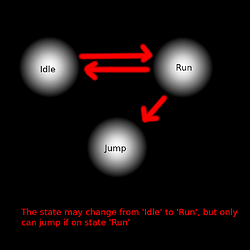Hi! I have a few questions about how animations work in Armory. I don’t had used it before, so i have no idea about how it works. I plan to create a state machine if i see any possibility. But i also don’t know what is the point of a animation state machine yet. Is there any difference between a animation state machine (like the ones in unreal, unity, etc.) and a animation finite state machine or they are just the same? Any documentation about this would be of great help!
To illustrate what i am asking, see this blend file: https://drive.google.com/file/d/13_9OP2B4UpEapawibtfziDtnbi-hbSl6/view?usp=sharing
Controls: 'W' to walk, 'S' to idle, 'Shift' to run and 'Space' to jump.
I have only three questions yet:
-
I see that the blending between the animations are not correct. Looks like the “previous animation” snaps to its end frame before get interpolated. What is wrong here? Do i need to make sure that this previous animation is in the last frame before blend to another?
-
The two functions: play() and blend() works differently.
Blend animationcan be updated every frame andplay animationmust be used just a single time because it starts from the initial frame of the animation. Apparently is no blending when you play an animation troughblend()and after play another animation troughplay(). Anyway to get it working? -
How do blending animations work if two animations (one with 10 frames and another with 60 frames) are blended? What is the frame of the animation then? Or this is literally two animations playing at the same time? If it is two animations at the same time, is possible to get the current frame of each one?
Thanks in advance!
 I think i am understanding its concept now.
I think i am understanding its concept now.


